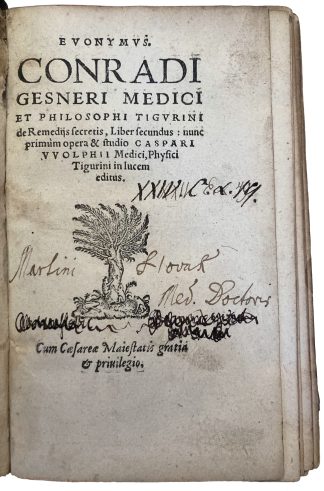GESNER, Conrad.
ILLUSTRATED CHEMISTRY
Euonymus. […] De Remediis Secretis. [...] Liber secundus.
Zurich, Christoph Froschouer, 1569.£2,850.00
FIRST EDITION. 8vo. 2 parts in 1, ff. [8], 237, [11]. Roman letter. Woodcut printer’s device to title, 52 small woodcut chemical equipment, decorated initials and ornaments. Fep slightly adhering at gutter of title, light toning, intermittent tiny worming to outer or lower blank margin, very occasionally just touching a letter, developing to very fine trail on a few ll. A very good copy in contemporary vellum, lacking ties, yapp edges, painted green, paint worn at lower outer edge and parts of spine, probably later rear eps, a.e.r. c1700 inquisitorial ms ‘Conradus Gesnerus auctor 1 Classis prohibitus’ and shelfmark to fep, C18 shelfmark and C17 ms ‘Martini Slovak Med[icinae] Doctoris’, plus crossed-out ms ex-libris, to title.
First printing of the posthumous second part of this most successful, charmingly illustrated ‘book of secrets’, edited by Caspar Wolf. Conrad Gesner (1516-65) studied natural and medical science at Basle, Montpellier, and Zurich. Renowned for his zoological masterpiece, ‘Historia animalium’, he was also an expert on botany and compiler of florilegia on surgery. First published in 1552, under the pseudonym Euonymus Philiatrus, Part I of ‘De Remediis Secretis’ quickly became one of the most popular medico-alchemical books of the time, contributing to the wide diffusion of Paracelsian theories. It reprised the structure of the successful medieval genre of ‘books of secrets’, which provided information and recipes for herbal medicine and the combination of substances useful for domestic management. Part II was similarly popular. It focused however solely on the ‘chimia’ of waters, oils and sauces – substances obtained artificially through distillation – giving precise instructions and detailed illustrations of the equipment required for professional results. For each Gesner lists all the infirmities that can be treated. Chap. 1 is devoted to various distillation techniques (e.g., by exposure to the sun, ‘per balneum’, using a furnace, by filtration), the chemical changes liquids undergo during the process, and special vessels required – some being Gesner’s own work. Chap. 2 provides recipes for distillations from wine (‘quintessentiae’), herbs or animals and their parts (e.g., capon), as well as composite and metallic waters (e.g., ‘aqua forte’), and precipitations produced from Mercury. Chap. III is entirely devoted to oils, including balms, extracted from flowers, seeds, fruit, spices, gum and resin, antimony, as well as from less obvious materials such as paper, cloth, linen and wood. Chap. IV explains the preparation of ‘aqua vitae’, juices, salts and (at length) ‘drinkable gold’ or ‘gold oil’, made from gold leaf and lemon juice, and used ‘against the plague and many other infirmities’. A practical book for everyday consultation.
A c1700 inquisitor noted on the verso of the front ep that Gesner was a ‘first-class author’, i.e., that his entire works were prohibited by the Church.
NYAM, NLM, Minn and Wisc copies recorded in the US. Durling 2087; Heirs of Hyppocrates 308 (German ed.); Wellcome I, 2785; Ferguson, Secrets, II, 22; Ferguson I, 315; Duveen p.247; Brunet II, 1565; USTC 624814; VD16 G1807; Simon (earlier eds).In stock










